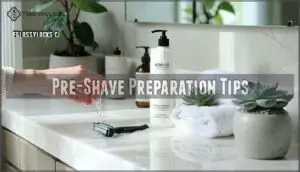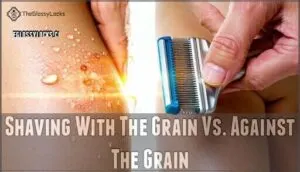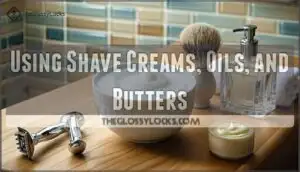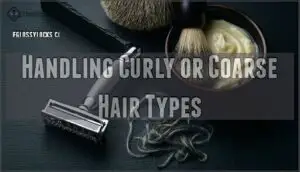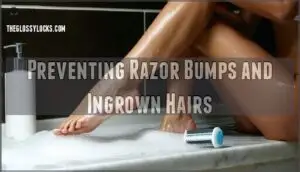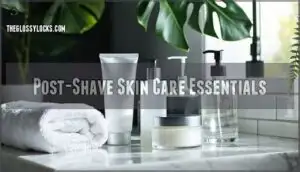This site is supported by our readers. We may earn a commission, at no cost to you, if you purchase through links.
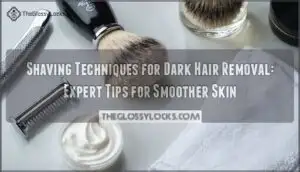 Dark hair shows every misstep—the contrast against your skin means razor bumps, ingrown hairs, and irritation announce themselves like unwelcome guests at a party.
Dark hair shows every misstep—the contrast against your skin means razor bumps, ingrown hairs, and irritation announce themselves like unwelcome guests at a party.
As a dermatologist, I’ve seen countless patients struggle with post-shave inflammation, often because they’re using techniques designed for lighter, finer hair that simply don’t work for thicker, coarser strands.
The good news? With the right razor, proper preparation, and a few strategic adjustments to your routine, you can achieve smooth results without the aftermath of redness and bumps that might have you reaching for turtlenecks in summer.
Table Of Contents
Key Takeaways
- Dark hair’s contrast against skin makes razor bumps and ingrown hairs more visible, so you’ll need sharper blades, consistent exfoliation, and techniques designed for thicker, coarser strands rather than lighter hair.
- Safety razors cut hair at skin level and reduce ingrown hairs better than multi-blade razors, which cut beneath the surface and can shorten blade lifespan while costing more over time.
- Proper prep matters as much as the razor itself—shave after a warm shower when pores are open, use shave creams or oils instead of soap, and always shave with the grain first to prevent irritation.
- Post-shave care prevents long-term problems by moisturizing within three minutes, sanitizing and drying your razor after each use, and exfoliating once or twice weekly to stop ingrown hairs before they start.
Choosing The Best Razor for Dark Hair
Finding the right razor makes all the difference with dark hair, especially when you want a smooth finish without irritation.
Let’s talk through what sets certain options apart, from safety razors to modern multi-blade picks.
Here’s what you’ll want to keep in mind as you choose.
Safety Razors Vs. Multi-Blade Razors
When you’re weighing razor selection for dark hair, think of safety razors as the steady classic—offering lower erythema incidence and cutting hair at the skin’s surface, which helps prevent ingrowns. Multi-blade razors may cut beneath the skin for a closer finish but often shorten blade lifespan and cost more over time.
Safety razors’ design helps in reducing ingrown hairs compared to multi-blade options. Good hygiene practices matter for both.
Features to Look for (ergonomic Handle, Serum-infused, Etc.)
Once you’ve got the basics down, it’s worth paying attention to the little extras—like a comfy grip or some soothing serum strips—that can make every shave feel a bit more thoughtful and a lot less hassle.
Ergonomic design, a sure grip, a pivoting head, or even a good lubrication strip on quality blade material improve your razor selection.
Product Recommendations for Sensitive Skin
If your skin throws a bit of a tantrum after shaving, the right razor can make all the difference in keeping everything calm and comfortable. Look for hypoallergenic options, fragrance-free formulas, and soothing ingredients like aloe.
Budget-friendly choices exist, but remember that razor compatibility with your skin care and aftershave routine is just as key to easing sensitive skin.
Razor Maintenance and Blade Replacement Tips
Keeping your razor sharp and fresh is just as important as picking the right one, especially if you want that calm, comfortable skin to last beyond your first few shaves.
Swap out razor blades every five to ten shaves—dull blades lead to irritation. Use gentle cleaning solutions, dry and store your razor upright, and dispose of blades safely to prevent nicks.
Pre-Shave Preparation Tips
Before you even pick up your razor, a little prep goes a long way. These quick steps can make your shave smoother and keep your skin feeling its best.
Here’s what to keep in mind before you start.
Cleansing and Exfoliating The Skin
Ever notice how your face feels instantly fresher after a deep clean, almost like it finally took a big breath of air?
Pre-shave cleansing clears away dirt and oil, while gentle exfoliation methods—think mild scrubs or enzyme washes—uncover smoother skin. For sensitive skin, look for calming product ingredients.
Frequency matters; enough exfoliation makes shaving safer and skin preparation even more effective.
When to Shave for Best Results
After a long, steamy shower, your skin is at its softest, making it the perfect moment to reach for your razor. The warmth loosens hairs and relaxes pores, so you glide, not tug. For the best results, keep these in mind:
- Choose gentle Shower Timing
- Mind Skin Sensitivity
- Trim to manageable Hair Length
- Adapt routines with Seasonal Adjustments
Avoiding Soap and Choosing Better Alternatives
If you’ve ever reached for that bar of soap before shaving, trust me—there are far better ways to set your skin up for a smooth, comfortable shave.
Soaps’ drying effects can leave your skin parched and prone to irritation. Instead, opt for a nourishing shave cream, creamy shave gel, in-shower lotions, or oils—these alternatives protect, hydrate, and cushion every pass.
Opening Pores for a Smoother Shave
Think of warm water as your skin’s friendly invitation—softening hairs and coaxing pores open so your razor glides instead of fights.
Before shaving, try these steps:
- Shower Timing: shave at the end of a warm shower.
- Facial Steaming: gently steam for a minute or two.
- Warm Compresses: press a washcloth to your face.
- Hydration Importance: drink water beforehand.
- Exfoliation Benefits: exfoliate your skin before shaving to increase smoothness.
Effective Shaving Techniques for Dark Hair
Getting a smooth, irritation-free shave takes more than just a quick swipe of the razor.
There are a few simple techniques that can make a big difference, especially for dark or coarse hair.
Let’s walk through some smart ways to get the results you want.
Shaving With The Grain Vs. Against The Grain
Wondering if changing the direction of your razor could make a difference for your skin? Shaving with the grain—a fancy way of saying “go with hair growth direction”—helps prevent ingrown hairs and razor bumps.
If you’re after a closer shave, try a second pass gently against the grain. This approach balances skin sensitivity impact and smooth results.
Using Shave Creams, Oils, and Butters
Imagine this: your razor glides like skates on fresh ice—now that’s the magic a good shave cream, oil, or butter can reveal. The right product consistency cushions sensitive skin, makes gliding simple, and softens coarse stubble.
Cream ingredients soothe and hydrate, oils trap moisture, and butters melt in, reducing friction—each formula brings its own boost for a smoother shave.
Handling Curly or Coarse Hair Types
After nourishing your skin with rich shave creams or oils, you’ll find that managing curly or coarse hair comes with its own rhythm. Thicker hair diameter calls for patience and smart tactics. Try these for a smoother, kinder shave:
- Pre-shave softening with a hot cloth
- Shaving with the grain
- Spacing out shaving frequency
- Choosing single-blade razors for ingrown prevention
To further mitigate irritation, consider using shaving creams designed for sensitive skin.
Tips for Shaving Difficult Areas (knees, Chin, Etc.)
Start by stretching or contouring your knee to reveal every dip; bend around knuckle creases and ankle curves using light, steady strokes.
For chin angles or underarm folds, employ short, controlled passes to avoid irritation. Tackle one tricky spot at a time.
Adapting your shaving routine for these curves is key to mastering shaving techniques for dark skin.
Preventing Razor Bumps and Ingrown Hairs
Nobody wants pesky bumps or stubborn ingrown hairs ruining that smooth finish.
There are a few things you can do to keep your skin calm and happy after shaving. Here’s what you should watch for and how to protect your skin.
Common Causes for Sensitive and Dark Skin
Although everyone’s skin tells its own story, those with dark skin face unique hurdles regarding shaving techniques for dark skin and preventing razor bumps and ingrown hairs. Sensitive skin can be traced to many sources:
- Increased TEWL rates, causing dryness
- Frequent pigmentary disorders after irritation
- Genetic factors heightening skin reactions
- Inflammatory dermatoses triggered by harsh products
Single-Blade Razors and Reduced Shaving Frequency
If your skin is prone to react to every little thing, swapping to a single-blade razor and spacing out your shaves might just be the calm your face has been asking for.
This change in shaving intervals and blade angles means less irritation, fewer razor bumps, and more cost savings—especially helpful for shaving for Black men aiming to prevent ingrown hairs.
Importance of Clean Blades and Proper Technique
No matter how steady your hand, a clean blade and the right technique are what turn a routine shave into a smoother, safer experience. Blade sharpness matters for efficient shaving—dull blades drag and raise your odds of cuts.
Consistent technique and strict hygiene practices aren’t just shaving tips—they’re your best defense against irritation, especially for Black men preventing ingrown hairs:
- Rinse blades thoroughly after every use
- Use gentle, even strokes—don’t rush the process
- Swap out your razor at the first sign of tugging or rust
Exfoliation and Pre/Post-Shave Care Routines
When exfoliating skin becomes part of your shaving preparation tips, you’re setting yourself up for success. Pre-shave oils soften hair and reduce friction by nearly half, while gentle exfoliation frequency—once or twice weekly using chemical exfoliants like AHAs—cuts ingrown hair risk by 60%.
Post-shave balms with glycerin restore your skin’s barrier repair function, preventing ingrown hairs and reducing irritation. This postshave skin care routine transforms your results.
Post-Shave Skin Care Essentials
Your skin deserves just as much attention after shaving as it does during the process. The right post-shave routine can make the difference between smooth, comfortable skin and days of irritation.
Here’s what you need to focus on to protect your skin and keep your tools in top shape.
Moisturizing and Hydrating After Shaving
Right after you shave, your skin is like a sponge that’s ready to soak up moisture—and giving it what it needs can make all the difference between calm, smooth skin and a dry, irritated mess. Application timing matters here, so don’t wait—reach for a moisturizer within three minutes.
Look for lotion ingredients like almond oil or shea butter that offer oil benefits without clogging pores, especially if you have sensitive skin. Quality hydration can keep your skin healthy for up to 24 hours.
Sanitizing and Storing Your Razor
Your razor might be your go-to tool for smooth skin, but without proper cleaning and storage, it can become a breeding ground for bacteria—and that’s the last thing you want touching freshly shaved skin.
After each shave, rinse your blade thoroughly with hot water, then sanitize it with rubbing alcohol. Pat it dry with a clean towel to prevent rust, and store it in a dry spot away from shower spray.
Proper razor sanitation and drying methods extend blade longevity while protecting your hygiene.
Managing Redness, Dryness, and Irritation
Even with the best shaving technique, redness and irritation can still show up—especially if your hair is dark, coarse, or curly. To soothe dryness and prevent irritation, apply moisturizer immediately after patting your skin dry.
Here’s how to manage post-shave discomfort:
- Reduce redness with aloe or fragrance-free lotion
- Prevent razor bumps by avoiding tight clothing right after shaving
- Treat ingrown hairs with gentle exfoliation and warm compresses
Consistent postshave care makes all the difference in keeping skin calm and comfortable.
Frequently Asked Questions (FAQs)
How often should dark facial hair be shaved?
Shaving frequency depends on your hair regrowth speed, skin sensitivity level, and desired smoothness.
Those with thick facial hair may shave every two to three days, while others prefer weekly hair removal to minimize irritation and allow the skin to recover between shaves.
What causes stubble shadow after shaving dark hair?
Stubble shadow appears when dark hair follicles remain visible beneath translucent skin after shaving.
The melanin concentration in your hair creates contrast against lighter skin tones, making the follicle’s root noticeable even when facial hair is cut at surface level.
Are electric razors better for thick dark hair?
Electric razors offer convenience for thick dark hair, but traditional razors generally deliver a closer shave.
Foil vs rotary designs affect skin sensitivity differently, while corded vs cordless impacts power for coarse hair follicles.
How long does dark hair take to regrow?
Terminal hair takes about two to four days to become visible after shaving. That’s because dark hair grows roughly 3 to 5 millimeters daily, depending on Regrowth Factors like hormones and genetics.
Conclusion
The proof is in the pudding—when you combine the right tools with proper shaving techniques for dark hair removal, your skin responds with less inflammation and fewer ingrown hairs.
Thick, dark hair requires patience, sharp blades, and consistent exfoliation to keep those unwelcome bumps at bay.
Your skin deserves the same attention you’d give any long-term investment, and with these strategies in your routine, you’re setting yourself up for smoother results that don’t require a cover-up.
- https://www.onebladeshave.com/blogs/blog/shaving-tips-for-black-men-part-i
- https://montrosedermatology.com/uncategorized/shaving-effects/
- https://pmc.ncbi.nlm.nih.gov/articles/PMC7984395/
- https://milanlaser.com/blog/laser-hair-removal-vs-shaving
- https://www.bodespa.com/blog/the-ultimate-shaving-guide-for-dark-skin

